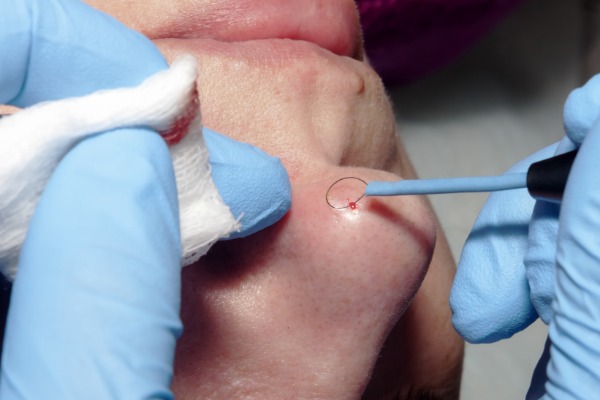
Procedure Time: Approx. 15-30 minutes
Recovery Time: Minimal healing time
Results Duration: Permanent removal of the lesion
Cost: Start from £100
Anaesthesia: Local anaesthesia
For a full list of FAQs please Click Here.

Procedure Time: Approx. 15-30 minutes
Recovery Time: Minimal healing time
Results Duration: Permanent removal of the lesion
Cost: Start from £100
Anaesthesia: Local anaesthesia
For a full list of FAQs please Click Here.
Radio Surgery (Radiofrequency or Radiowave Surgery) is used to remove moles, warts, skin tags and other so called ‘lumps and bumps’. It involves the passage of radio waves into the skin to perform the removal or reshaping of a lesion. Different types of electrodes are used depending on the type of lesion, e.g. fine needle, wire loop, scalpel blade etc. Expect minor swelling, redness, bruising and tenderness in the area for a few days as it heals. There should not however be any bleeding due to the tissue coagulation during treatment. Private prices for radiosurgery will depend upon the size and condition being treated; the removal of small moles, warts or skin tags start from approximately £100.
Moles, warts, skin tags and other so called ‘lumps and bumps’ can be both upsetting to look at and cause social and psychological unease for those whose face is blighted by such growths. With increases in the occurrence of skin cancers we are well advised to seek professional, medical advice about any growths which appear over night or change dramatically in appearance. Thankfully though, most growths are benign and harmless, and removal is often quick and simple with reassuring cosmetic results.
The term Radiosurgery is quite confusing in medicine as the term actually refers to two different surgical modalities. It is worth taking the time to look at the differences between the two to make sure there is no confusion.
The first radiosurgery (Stereotactic Radiotherapy) is a medical procedure which allows non-invasive treatment of benign and malignant conditions as well as vascular malformations by means of directed beams of ionizing radiation, such as gamma rays. This form of radiosurgery was first developed in Sweden in 1949 to irradiate brain tumour lesions.
The second type of radiosurgery (Radiofrequency or Radiowave surgery) is the cutting of tissues using a high frequency alternate current. This surgical modality is very different from traditional electrosurgery and other forms of electrocautery as it can simultaneously cut and coagulate tissues without applying any pressure.
Traditional electrosurgery devices cut skin tissue by passing an electric current through the patient and using the electrode tip (a platinum wire) to provide resistance, effectively causing high temperature heating of the electrode tip and excessive lateral (surrounding) tissue damage. There is also potential risk of shock and burn to the patient as well as post operative pain from unsealed nerve endings.
The principle of radiofrequency or radiowave surgery is that it uses high frequency radiowaves, at 4.0 MHz, to deliver low temperatures through radiofrequency (RF) micro-fibre electrodes. The waveband utilised is similar to the frequency of marine band radios.
The difference between this method and electrosurgery is that the tissue serves as the resistance instead of the electrode. This means there is no heating of the RF micro-fibre electrode by the use of low temperature RF radiowave energy. Instead, the intracellular tissue water provides the resistance and vaporises without the heat and damage seen in electrosurgery. This tissue vaporisation also results in significant haemostasis (stopping of the flow of blood) without actually burning the tissue. In addition, there is no danger of shocking or burning the patient.
Most important is the fact that there is controlled and minimal lateral tissue damage with 4.0 MHz high frequency, low temperature radiowave surgery. This effectively means less damage, less post operative pain, faster healing and less blood loss and better healing.
Radiofrequency or radiowave surgery is extremely versatile and can be used in many medical specialities including General Surgery, Craniofacial Surgery, Oral Maxillofacial Surgery, Gynaecology and Neurosurgery.
In Dermatology and Cosmetic Medicine it is used for minor surgical procedures such as removing telangiectasias (thread veins), sculpting rhinophyma (bulbous growths on the nose), flattening and sculpting nevi (birthmarks and moles), postsurgical irregularities, scars revision, sebaceous hyperplasia (cauliflower shaped growths), ‘‘unroofing’’ cysts, etc.
In Plastic Surgery it is used in many aesthetic procedures such as eyebag removal (blepharoplasty) and facelifts (rythidectomy).
Many studies have shown the technology also provides excellent results during removal of superficial carcinomas (e.g. skin cancers) as well as debulking and delineating deeper skin cancers as in Mohs surgery.
Uses of RF in dermatosurgery:
Advantages of radio-surgery include:
Careful discussions regarding your reasons for wanting treatment are very important before you begin the treatment. You must also make sure that this treatment can deliver what you want and how you would like to look afterwards. Your practitioner should be able to answer all these questions.
A medical history should also be taken to make sure that there are no reasons why you shouldn’t undertake treatment. You may be asked to read detailed information and sign a consent form which means that you have understood the potential benefits and risks associated with the procedure.
Photographs may also be taken by the practitioner for a "before and after" comparison at a later date.
Procedure
Radiofrequency surgery involves the passage of radio waves (frequency of 1.5 to 4.5 MHz) into the skin to perform removal or reshaping of a lesion. The commonest frequency used is 4 MHz.
The radio waves are generated by a radiosurgery unit, which creates a very high-frequency radio wave. The radio-surgical unit consists of an electrode, a ground plate and a transformer.
The ground plate or antenna is plastic coated and is usually placed under the patient. The “patient electrode” looks like a small loop and is held by the operating surgeon during the procedure. Different types of electrodes are used depending on the type of lesion e.g. fine needle electrode, wire loop electrode, scalpel blade electrode etc.
The lesion should be touched with the tip of the electrode. It generates very little heat as compared to conventional electro-cautery. This results in negligible collateral damage, resulting in faster healing and minimal scarring. The radiowaves travel from an electrode tip to the lesion and return to the unit through the ground plate. When radio energy passes between the ground plate and the patient electrode, it is concentrated at the electrode end, resulting in the release of energy, which produces steam within the cells, thus vapourising them and dividing the tissues. This occurs because of heat produced by the tissue resistance to the passage of a high-frequency wave. The heat makes the intracellular water boil and thereby increases the cell inner pressure to the point of breaking it from the inside to the outside. This phenomenon is called a cellular volatilisation.
Unlike with electrocautery, the electrode remains cold and no electrical contact needs to be made between the patient and the ground plate.
Many studies have demonstrated significant advantages to the use of electrosurgical incision, including shorter operating time, reduced postoperative pain, and sealing of lymphatics during excision of malignant tumours.
The actual procedures are generally well tolerated, due to the administering of local anaesthesia. You may feel small tugging sensations in the area during treatment as the growth is removed but should not feel pain.
Expect minor swelling, redness, bruising and tenderness in the area for a few days as it heals. There should not however be any bleeding due to the tissue coagulation during treatment.
In very rare cases minor electrical shocks or burns can be experienced due to the patient coming in contact with another metal surface during treatment, such as touching a metal part of the bed. An experienced practitioner will advise on the best position for you to maintain during treatment.
It is very important that you follow the advice of your practitioner carefully after any radiosurgery treatment to help to ensure the success of the procedure and reduce the risk of complications.
Post-treatment recommendations may include:
Women who are pregnant or breastfeeding are generally not considered to be suitable candidates. You should wait until after you have had your baby and ceased feeding before having radiosurgery.
Patients fitted with a cardiac pacemaker should also not be treated with radiosurgery.
Generally a suitably trained and experienced doctor, dermatologist or cosmetic surgeon should perform all treatments that involve radiosurgery.
Please also note that all clinics offering minor surgical treatments should be registered with the Care Quality Commission. Clinics need to follow certain standards for the safe operation and maintenance of the machines that they use and the sterility of the environment in which they operate, and receive regular inspections to ensure that national minimum standards are followed.
For more information about practitioner training, qualifications and relevant medical organisations please view the information contained within the Legislation section of the Consulting Room.
It is unlikely that anyone considering radiosurgery for the cosmetic removal of skin growths such as warts, moles, birthmarks, skin tags etc. would be able to access this free of charge on the National Health Service (NHS) unless there is an additional health problem associated with the condition, such as a mole which has changed dramatically in appearance recently and may therefore not be a benign growth.
However, we would always recommend that you visit your General Practitioner before embarking upon a private procedure. As well as their advice and guidance they may also be able to refer you to a local NHS Hospital who can treat you.
The NHS has set out the following guidelines on how to get cosmetic surgery through the NHS:
"To qualify for surgery on the NHS you must meet specific criteria as set out by your local health authority. The NHS will not pay for surgery for cosmetic reasons alone. Reconstructive and cosmetic surgery to correct, or improve, congenital abnormalities and injuries will usually be carried out free of charge.
NHS reconstructive surgery is performed by plastic surgeons who have had extensive training and belong to the British Association of Plastic Reconstructive and Aesthetic Surgeons. Surgeons who carry out cosmetic surgery through the NHS also belong to the British Association of Aesthetic Plastic Surgeons.
To receive cosmetic surgery from the NHS, you will normally need a referral from your GP. You will have a consultation with a plastic surgeon and an assessment by a psychiatrist, or psychologist. It will then be decided whether there is enough social, psychological, or physical benefit to be gained to justify surgery."
Private prices for radiosurgery will depend upon the size and condition being treated, however prices for the removal of small moles, warts or skin tags start from approximately £100.
Radiosurgery is a relatively new minimally invasive method of cutting and coagulating soft tissues and is used to remove and reshape skin tags, warts, growths, birthmarks, moles, scars and other 'lumps and bumps', as well as for cosmetic surgery procedures such as eyebag removal.
During this procedure, tissue to be treated is either removed or destroyed by electrical energy, which is then converted to heat because of tissue resistance.
Unlike electrocautery, the heat is generated in the tissues and hence the actual electrode remains cold so cannot burn or damage surrounding tissue. There is no pressure required during radiosurgery and the tissue cells are effectively vaporised in the path of the radiowaves, which causes them to split apart much like a hot wire through polystyrene.
Results vary enormously depending upon both the patient and the skill of the individual surgeon, so outcomes for cosmetic surgery procedures will always be more variable than those for less invasive non-surgical treatments.
All before and after photographs featured are real patients, your results may differ.
Radiosurgery is commonly used to remove moles and skin growths.
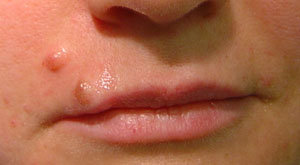
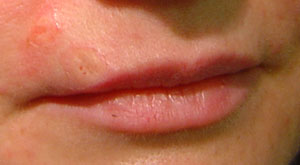
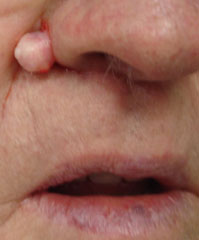
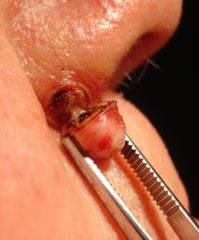
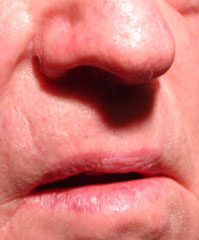
The use of radiosurgery for surgical cosmetic procedures such as blepharoplasty (eye lid surgery) – see this series of photos which illustrates the blood less process.
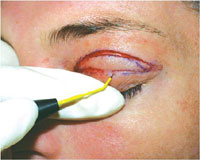 >
>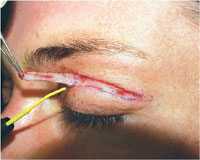
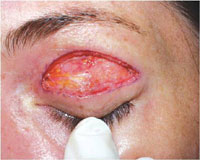
A case study showing before and after blepharoplasty with radiosurgery.
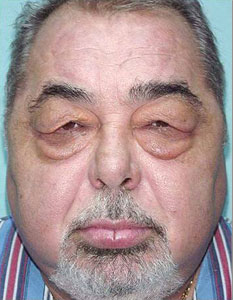
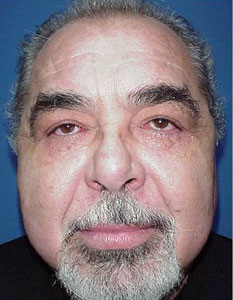
Photographs and case studies provided courtesy of Dr Patrick Treacy.